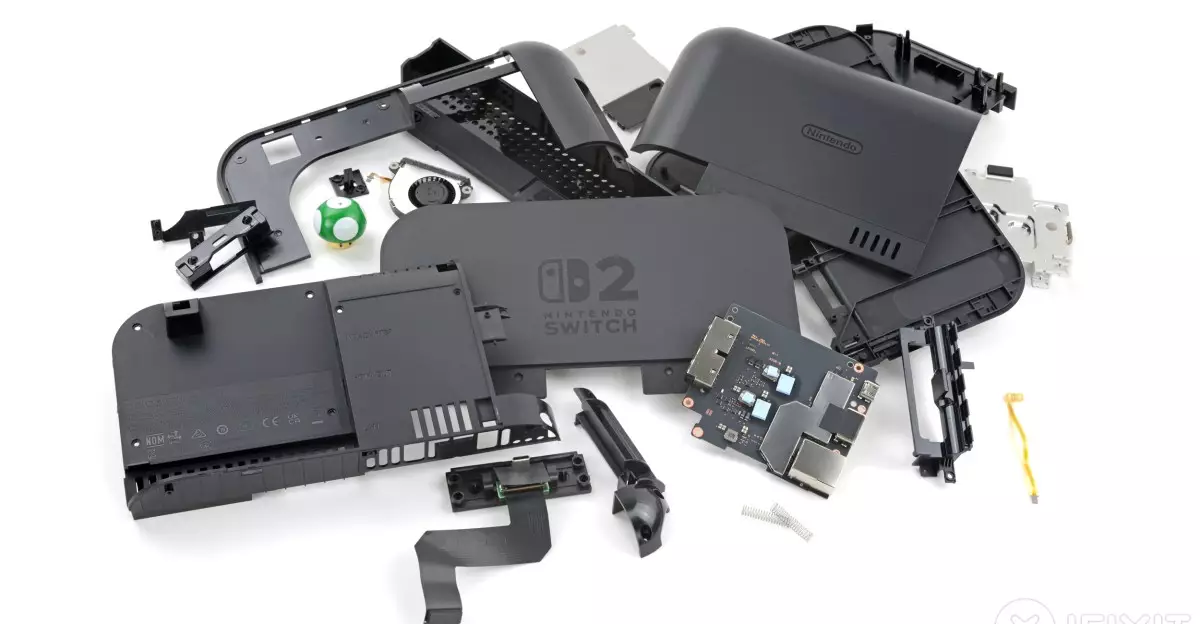As consumer electronics evolve, the excitement surrounding new gadgets often overshadows critical conversations about their design choices and long-term usability. Nintendo’s latest offering, the Switch 2, promised to elevate the gaming experience with cutting-edge technology. However, a closer inspection reveals a concerning trend: the prioritization of sleek design and sophisticated components at the expense of repairability. While it is commendable that Nintendo seeks to innovate, the implications for gamers and the environment are less than encouraging.
A Dismal Tear Down Score
The renowned repair experts at iFixit have not held back in their harsh assessment of the Switch 2, assigning it a meager 3 out of 10 for repairability. This starkly contrasts with earlier models, including the original Switch, which received an 8 out of 10 rating—until its score was readjusted to a mere 4 out of 10 as criteria evolved by 2025 standards. With parts that are increasingly challenging to access and replace, Nintendo seems to be turning its back on a repair-friendly legacy that many of its competitors are embracing.
The crux of the repairability woes lies in the choices made in the Switch 2’s assembly. The use of powerful adhesives to secure essential components such as the battery not only complicates the repair process but also raises questions about how sustainable this design is for the long haul. Gamers already burdened with expensive and fragile devices now face the added hassle of potential repairs that are not just costly but nearly impossible for the average user to conduct independently.
Access Denied: Hidden Components
For anyone looking to fix or upgrade their Switch 2, the process can feel like an exercise in futility—especially when dealing with the infamous tri-point screws. These screws have long been a hallmark of Nintendo’s designs. Still, the Herculanean task of unscrewing them is made worse by their concealment behind stickers that crumble upon removal. This design choice is an example of a company seemingly prioritizing aesthetic appeal and security over user accessibility. It seems as though Nintendo has not only reduced the repairability of its devices but has actively designed barriers for potential self-repair.
Moreover, the soldering of components directly onto the main board—most critically the flash storage modules and USB-C ports—makes potential upgrades or repairs nearly impossible for the average user. Those who had hoped to replace worn-out parts or upgrade their devices will find themselves at a significant disadvantage.
Temporary Fixes and Poor Design Choices
The teardown further illustrated the troubling decisions surrounding component connectivity and materials used in the Switch 2. Unlike previous models, certain parts—including the game card reader—are irreversibly soldered, mirroring the assembly practices found in the lower-end Switch Lite. This transition suggests a significant regression in user-oriented design, as users now find themselves deprived of modularity—a feature that once accentuated Nintendo’s appeal.
Another glaring issue is the use of various thermal pastes, which can fall short of efficient cooling performance over time. This design oversight pointedly indicates that Nintendo may not have prioritized long-term usability in their quest for innovation. Thermal paste that solidifies can leave the console susceptible to overheating, posing risks not only to performance but also to device longevity.
The Continued Strains of Joy-Con Design
Delving into the flagship accessories, the newly designed Joy-Cons are also undergoing scrutiny. With the same problematic joystick technology as their predecessors, these new controllers harbor the inherent risk of joystick drift, a bane for many dedicated gamers. The increased complexity of disassembling these components only compounds the frustration. The difficulty in replacing or repairing joysticks signifies that Nintendo is overlooking common user grievances while focusing on other aspects of gameplay experience.
In essence, while the Switch 2 may boast impressive specifications and features, its design heavily leans toward obsolescence. The barriers to repairs and replacements underscore a larger narrative in consumer electronics—the tug-of-war between innovation and user ease. It’s about time Nintendo reevaluated its priorities and returned to a design philosophy that empowers its users rather than leaving them at the mercy of costly repairs and potential e-waste.

